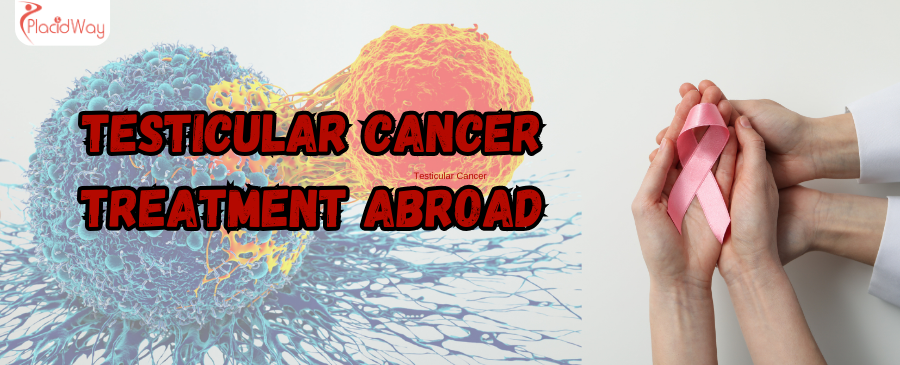Testicular Cancer
Cancer Treatment
Modified Date: 2024-11-12

Key Insights at a Glance
- Testicular cancer is a relatively rare but highly treatable cancer affecting the testicles.
- It is most commonly diagnosed in young men between the ages of 15 and 35.
- Early detection significantly increases the chances of successful treatment.
- The average cost of testicular cancer treatment abroad is generally lower than in the U.S.
- Choosing an accredited clinic ensures quality care and patient safety during treatment.
Testicular cancer occurs when abnormal cells in one or both testicles grow uncontrollably. It can arise from two main types of cells: germ cells (which produce sperm) and stromal cells (which support the structure of the testicles). The most common type is germ cell tumors, which can be further classified into seminomas and non-seminomas. While testicular cancer is rare, it has a high cure rate, especially when detected early.
- A lump or swelling in one or both testicles.
- A feeling of heaviness in the scrotum.
- Persistent dull ache in the lower abdomen or groin.
- Changes in the size or shape of the testicle.
- Back pain or abdominal discomfort.
| Treatment Type |
Description |
Success Rate |
| Surgery (Orchiectomy) |
Removal of the affected testicle and surrounding tissue. |
95%+ |
| Chemotherapy |
Use of drugs to kill cancer cells or stop their growth. |
80-90% for advanced cases. |
| Radiation Therapy |
High-energy rays to target cancer cells, mainly for seminomas. |
85-95% for localized cases. |
Safety Concerns Related to Testicular Cancer Treatment Overseas
- Ensure the clinic is accredited by recognized medical boards.
- Verify the qualifications and experience of the healthcare team.
- Discuss potential side effects and risks associated with each treatment option.
- Evaluate the clinic's post-treatment care protocols to minimize risks.
Advantages of Testicular Cancer Treatment Abroad
- Significant cost savings compared to U.S. prices, often up to 50% lower.
- Access to specialized oncologists with extensive experience in treating testicular cancer.
- Comprehensive care packages may include travel and accommodation.
- Reduced waiting times for treatment in many international clinics.
- Potential complications from surgery, such as infection or bleeding.
- Side effects from chemotherapy, including nausea, fatigue, and hair loss.
- Emotional and psychological effects from diagnosis and treatment.
- Risk of fertility issues due to treatment.
The procedure generally involves the following steps:
- Initial Consultation and Evaluation:
- A thorough assessment of the patient’s medical history and physical examination.
- Diagnostic imaging (ultrasound, CT scan) and blood tests are conducted.
- Surgery (Orchiectomy):
- Removal of the affected testicle through a small incision in the groin.
- Adjuvant Therapy (if necessary):
- Chemotherapy or radiation therapy may be recommended based on the stage of cancer.
- Post-Operative Care:
- Regular follow-up appointments to monitor recovery and detect any recurrence.
| Country |
Average Cost (USD) |
| USA |
$30,000 - $50,000 |
| Mexico |
$8,000 - $15,000 |
| Turkey |
$6,000 - $12,000 |
| Thailand |
$5,000 - $10,000 |
| Colombia |
$4,000 - $8,000 |
| India |
$3,000 - $7,000 |
For detailed pricing, please Find Prices for Testicular Cancer Treatment Near You.
How to Prepare for Testicular Cancer Treatment Overseas
- Consult with your healthcare team to discuss your health history and treatment options.
- Follow any pre-operative instructions, including dietary guidelines and medication management.
- Make arrangements for travel and accommodation prior to treatment.
- Prepare a support system for your recovery, including post-treatment care assistance.
What does testicular cancer treatment cost without insurance?
The cost of testicular cancer treatment without insurance can vary widely based on the location and facility. In the U.S., the price typically ranges from $30,000 to $50,000, while it can be significantly lower abroad, averaging between $3,000 and $15,000.
How successful is testicular cancer treatment?
Success rates for testicular cancer treatment are generally high, with many patients achieving remission. The success rates can range from 85% to 98%, depending on the stage of cancer at diagnosis and the individual patient's health.
Are there any risks involved?
Yes, like any medical treatment, there are risks associated with testicular cancer treatment, including surgical complications, side effects from chemotherapy, and potential fertility issues.
How long is the recovery period?
Most patients can expect to return to normal activities within a week or two after surgery, although full recovery may take longer depending on individual circumstances and the extent of treatment.
What if my symptoms persist after treatment?
If symptoms continue after treatment, further evaluation may be necessary, and alternative treatments or follow-up care may be considered.
How to Choose the Right Clinic for Testicular Cancer Treatment Abroad
- Look for accredited clinics with international certifications.
- Prioritize clinics with experienced oncologists specializing in testicular cancer.
- Review patient testimonials and success stories for quality insights.
- Inquire about comprehensive care packages that include pre and post-operative support.
- Ensure the clinic has modern facilities and follows strict hygiene protocols.
If you are considering treatment for testicular cancer, it is essential to consult with skilled professionals who can guide you through the process. PlacidWay can connect you with top-rated clinics specializing in this condition, ensuring you receive the highest standard of care. Don't let testicular cancer dictate your life any longer—take the first step towards recovery and improved well-being abroad!
